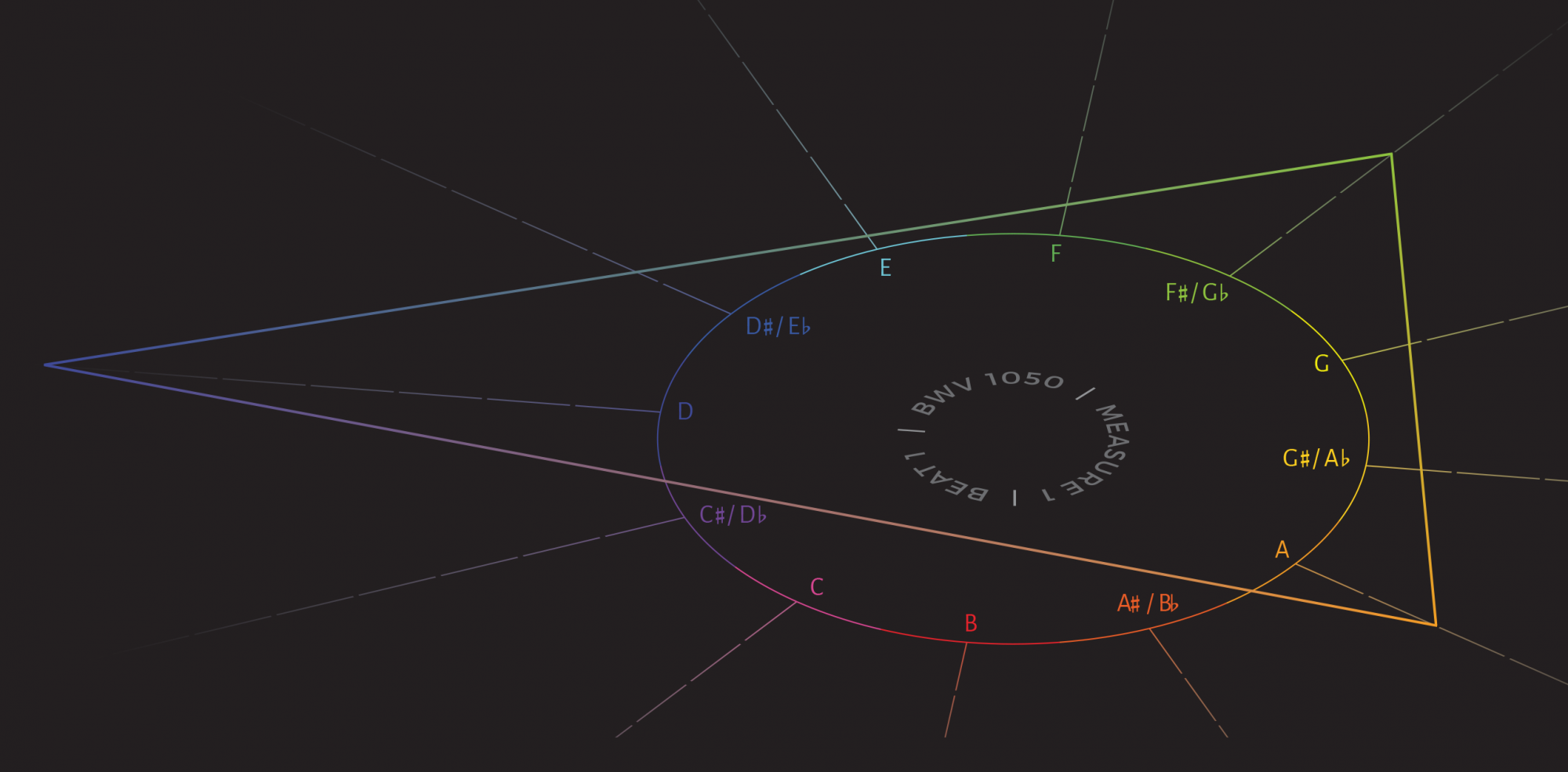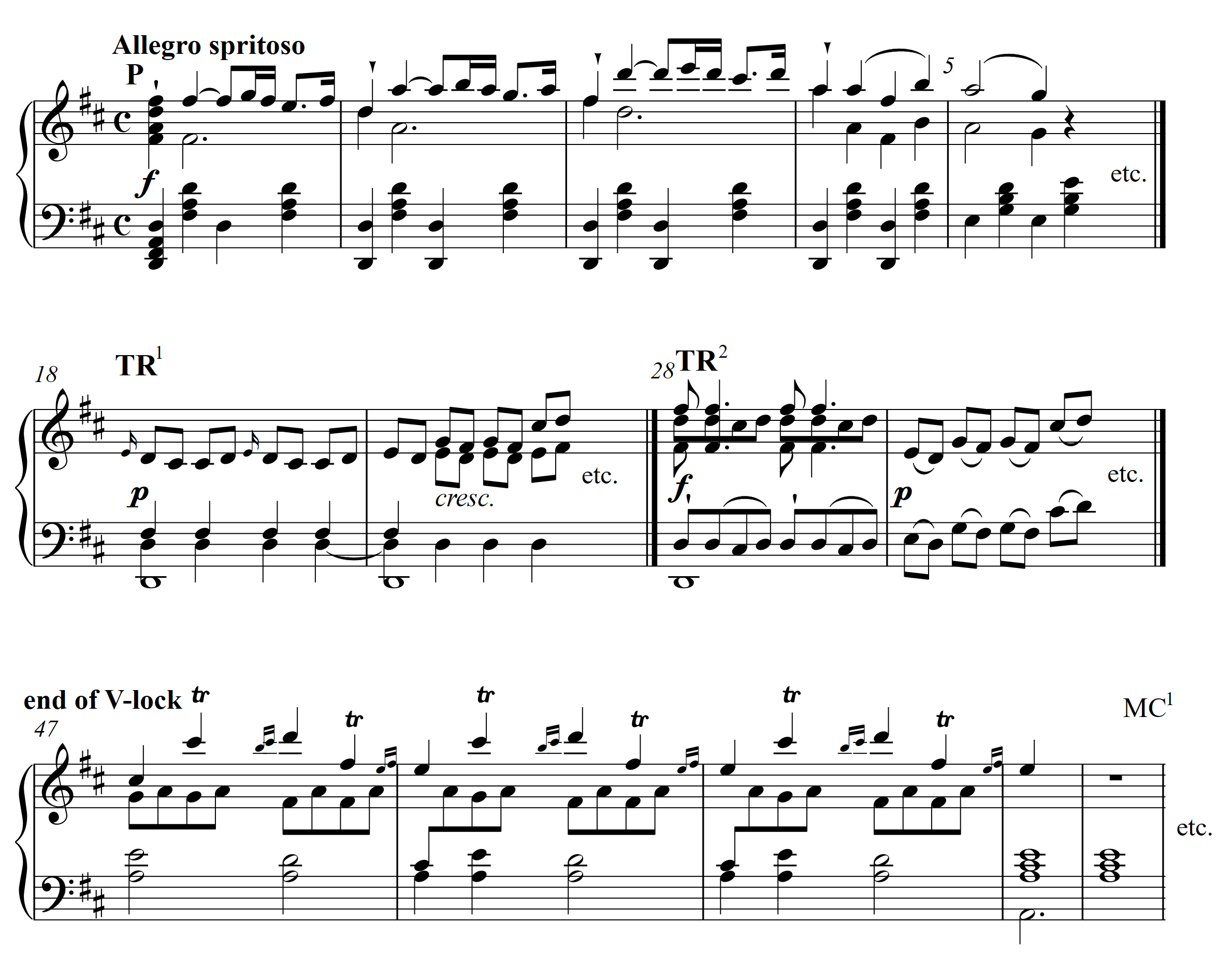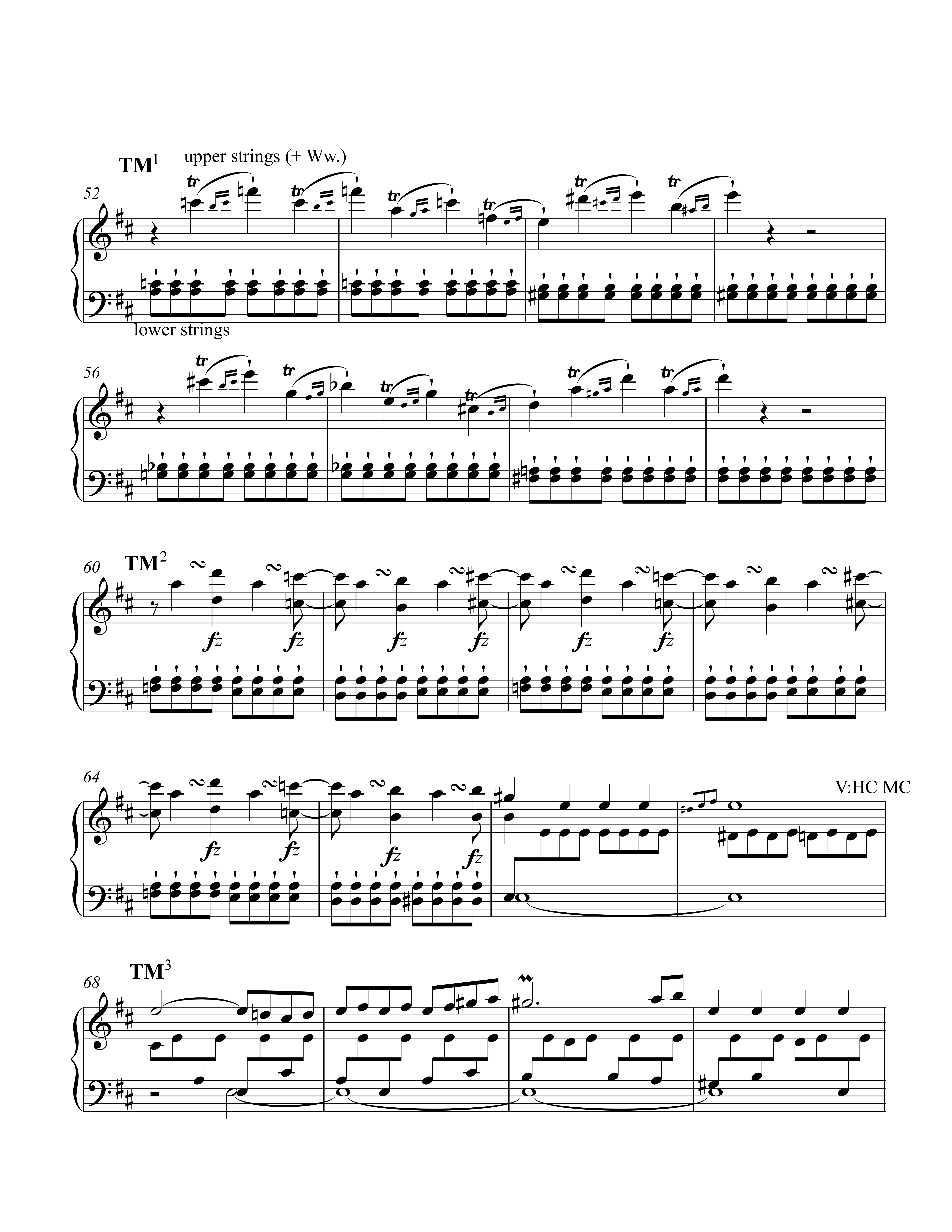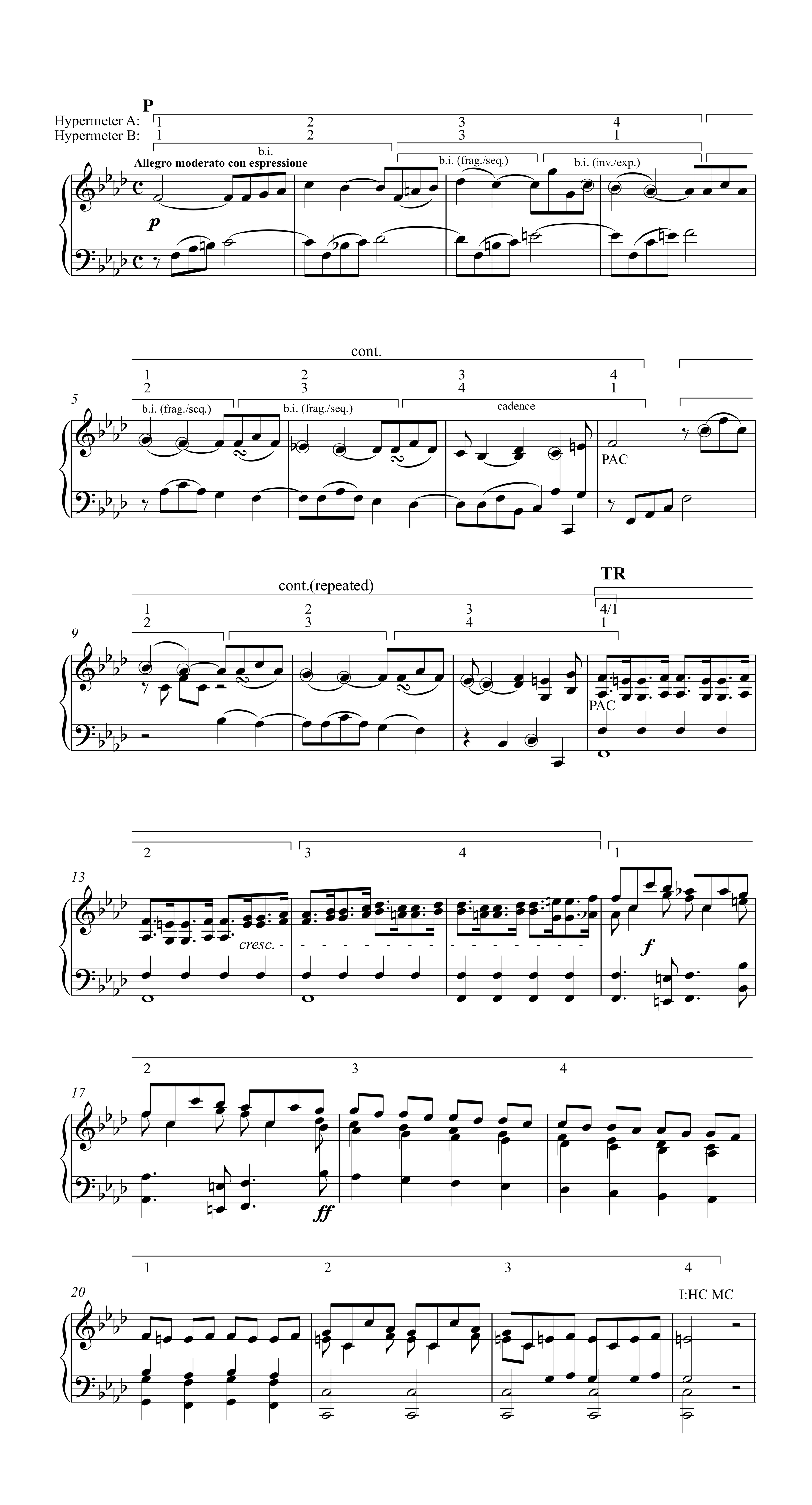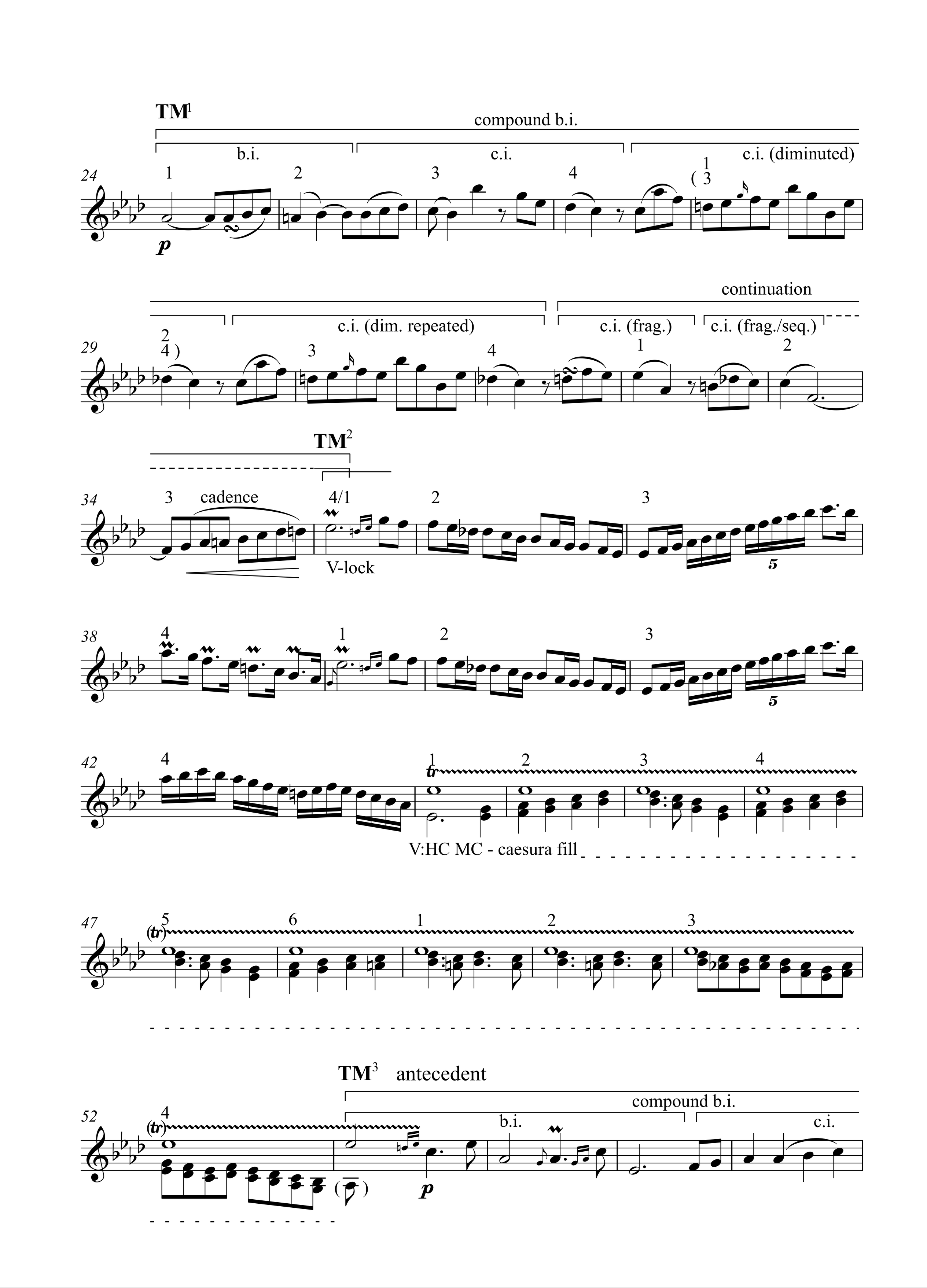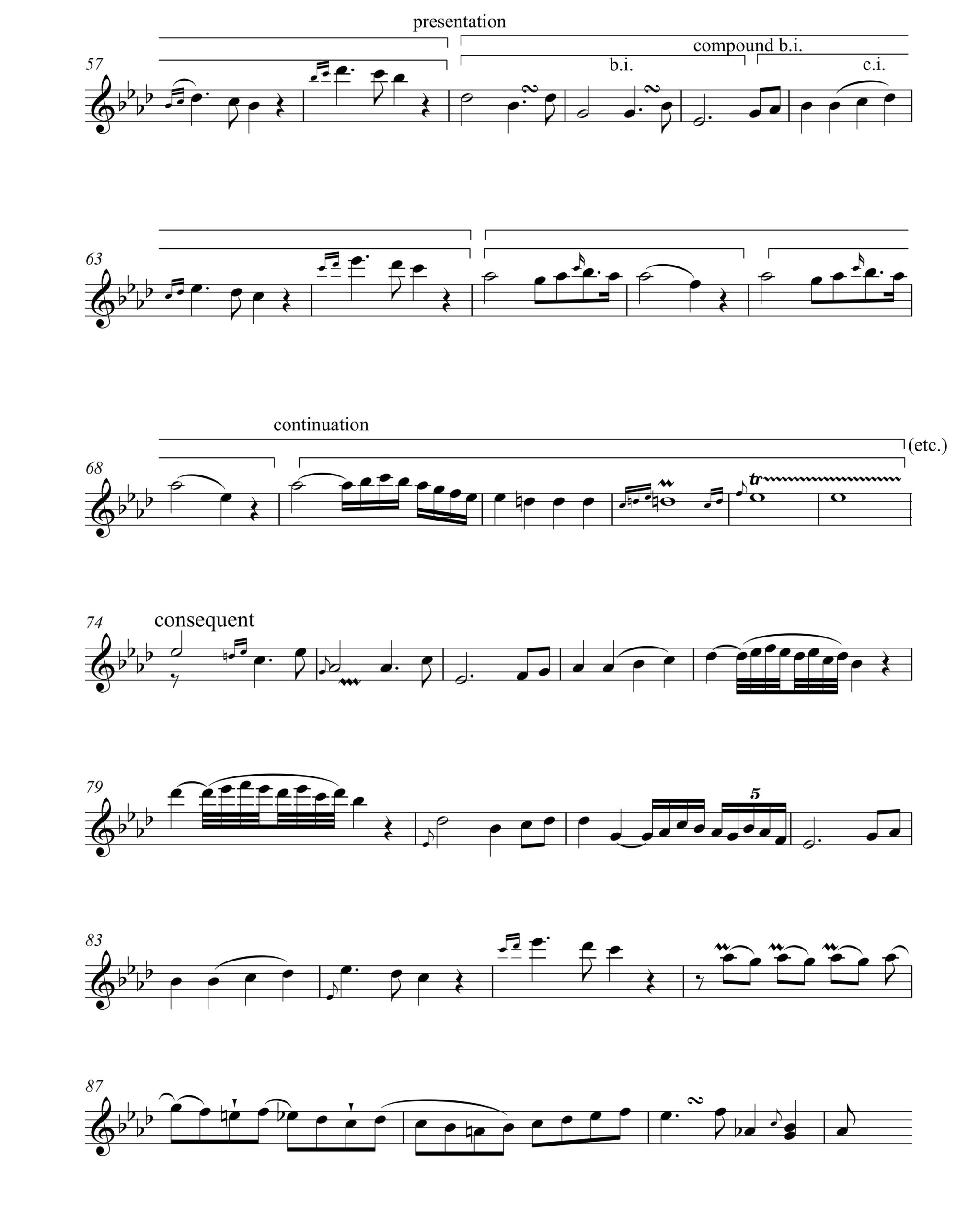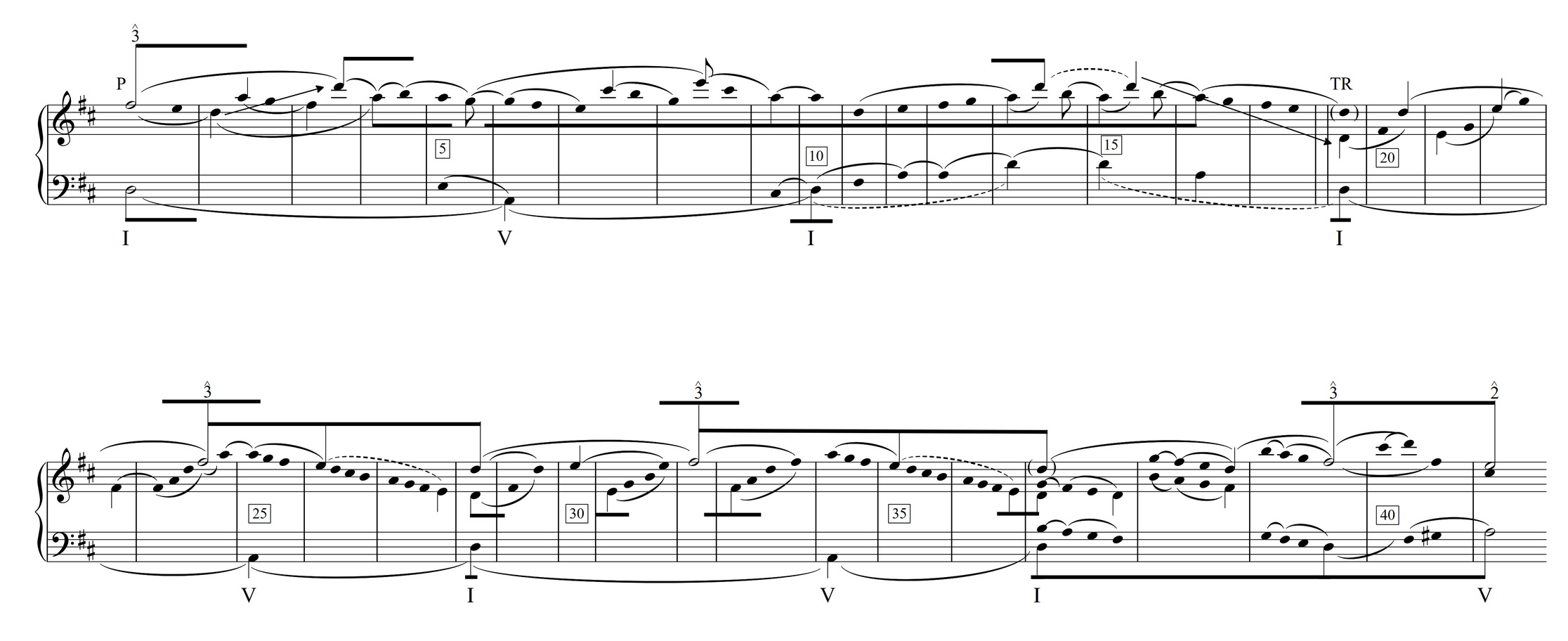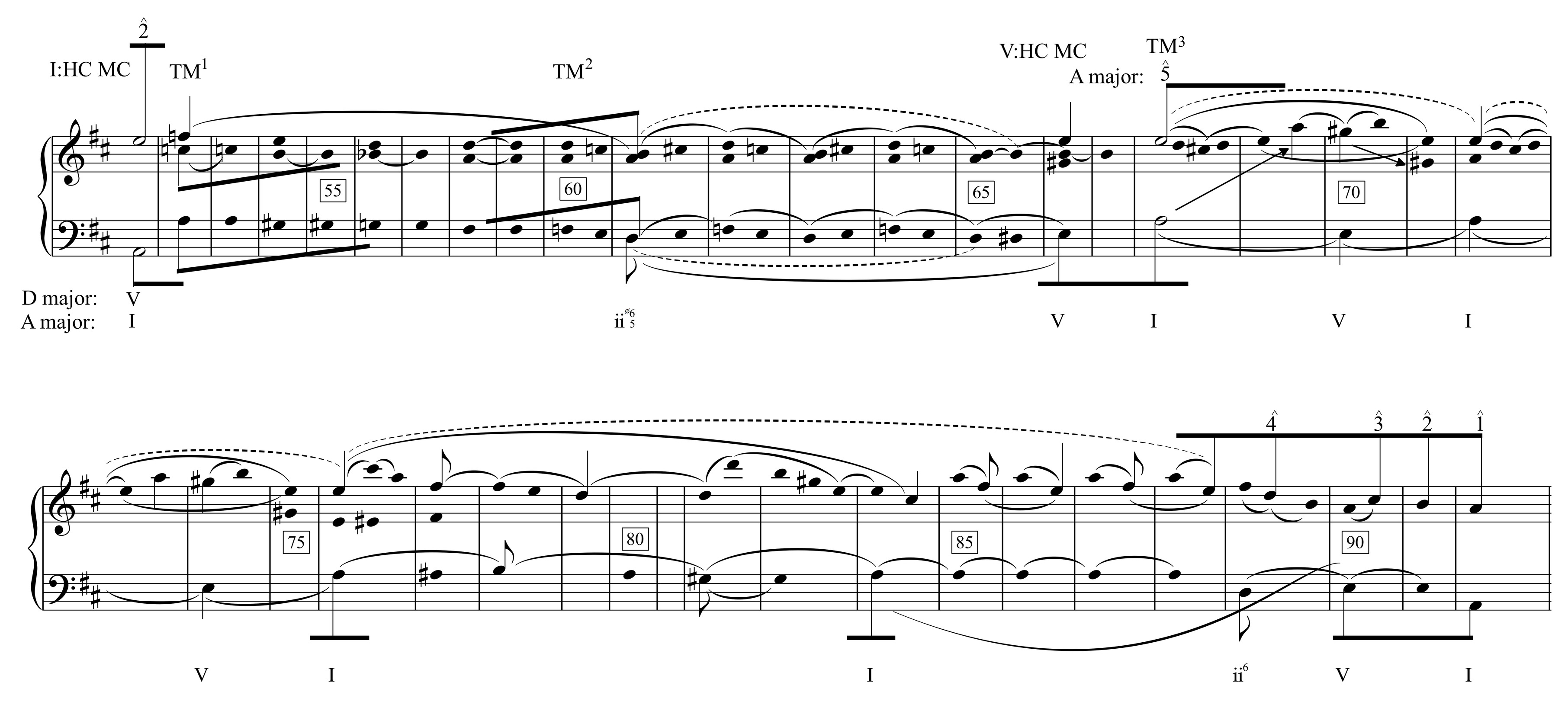Samuel Ng
Abstract
This essay examines how the “trimodular block” (TMB) in the first movements of Hélène de Montgeroult’s Piano Sonatas, op. 5 spotlights bel canto singing in her piano writing and pedagogy. While the TMB in op. 5 is readily identifiable, its narrative profile is not so much correcting a transgressive element as a discursive journey that anticipates the first true lyrical theme showcasing Italian bel canto singing on the piano. I discuss how this discursive path unfolds through three elements: orchestration/topics, phrase rhythm, and tonal structure. These three areas work in tandem to fulfill generic requirements of TM1 (the first proposed S-theme) while withholding critical features of Montgeroult’s bel canto writing until the lyrical S-theme at TM3. Montgeroult’s TMB thus gives unique rhetorical prominence to the S-theme, rendering its lyricism and cantabile character the focal point of the sonata exposition.
Keywords and Phrases: Hélène de Montgeroult; L’art de bien chanter; sonata form; trimodular block; orchestration; topics; phrase rhythm; tonal structure
The main purpose of this essay is to shed light on how a unique formal design of the Secondary Theme in the first movements of Hélène de Montgeroult’s Piano Sonatas, op. 5 (first published between 1804 and 1807) spotlights bel canto singing in her piano writing and pedagogy. Montgeroult’s lifelong preoccupation with l’art de bien chanter is well documented, especially in the “Preface” to her magnum opus and last work, Cours complet pour l’enseignement du forte-piano, conduisant progressivement des premiers elements aux plus grandes difficulte.1 Possibly influenced by the piano works of Jan Ladislav Dussek (Rose 2001, 100), the S-themes of Montgeroult’s sonata expositions in op. 5 consistently employ a procedure known as the “trimodular block” (henceforth TMB) in the parlance of James Hepokoski and Warren Darcy’s Sonata Theory (2006). The TMB is a particular design of the Secondary-Theme zone that consists of an initial attempt to present the S-theme, a failed confirmation or completion of this proposed S-theme and subsequent re-engagement of transitional rhetoric, and, finally, a successful presentation and confirmation of the de facto S-theme of the exposition. Hepokoski and Darcy call the first part of this three-stage process (“a flawed or unsatisfactory first S-idea”) TM1; the second part (“some sort of TR-texture-based corrective action”) TM2; and the third part (“a ‘better’ S-idea”) TM3 (2006, 172). As a whole, the TMB from this perspective engenders a sense of an unexpected detour, followed by amendatory maneuvers to get back on the expected course.
While the TMB in the first movements of op. 5 is readily identifiable, I argue that its narrative profile is not so much correcting a transgressive element as a discursive journey that anticipates a pivotal turn of events at TM3: the first true lyrical theme showcasing Italian bel canto singing on the piano.2 In the following paragraphs, I discuss how this discursive path unfolds through three elements: orchestration/topics, phrase rhythm, and tonal structure. These three areas work in tandem to fulfill certain generic requirements of TM1 (the first proposed S-theme) while withholding critical features of Montgeroult’s bel canto writing until the lyrical S-theme at TM3. In Montgeroult’s hands, the TMB thus gives unique rhetorical prominence to the S-theme, rendering its lyricism and cantabile character the focal point of the sonata exposition.
1. Orchestration/Topics
In this section, I examine Montgeroult’s formal narrative in terms of orchestration and topics—two considerations that are inextricably linked. Topics, as many scholars have noted, are often associated with particular instruments and timbres, whether literally employed or imitated through textural and rhythmic means.3 To examine “orchestration” in a piano work may seem odd to some, but it is well known that pianists—both as composers and performers—habitually think of their instrument in orchestral terms.4 A full treatment of this topic (no pun intended) is beyond the scope of this paper, but two well-known pianists will be summoned here to provide a précis. In an insightful collection of essays on piano performance and pedagogy, Boris Berman argues that knowledge of a composer’s entire oeuvre provides essential creative ideas for artistic interpretation (2000, 151). Beethoven’s late piano sonatas, for instance, must be considered in light of his string quartets, and Schubert’s piano sonatas heard against his entire output of lieder. This line of thinking points to the integral role of an imagined instrumentation in pianistic writing. Berman’s “orchestration” of the Trio of Beethoven’s Piano Sonata in E\flat
Expressing a similar viewpoint in an essay provocatively entitled “Turning the Piano into an Orchestra,” Alfred Brendel (1976) further highlights an aspect of the piano’s timbral versatility that supports my analysis. Brendel catalogues an extensive list of orchestral instruments that the piano imitates in Liszt’s paraphrases and transcriptions and concludes his discussion with an intriguing twist: “My list of musical instruments would be gravely incomplete without the human voice” (97). Subsequently, Brendel prescribes, with poetic flair, innovative (if somewhat idiosyncratic) ideas on how a pianist should imagine and recreate the vox humana: “In [the human voice’s] freedom of declamation it leaves the orchestra far behind. It is distinguished by warmth and directness. Its articulation is given shading by vowels and consonants, like sculpture in high relief. Its dynamics extend from whispering and humming to shouting. The voice is capable of every kind of expression. Vibrato, in all its degrees, characterizes singing; the arm of the pianist should sail on that vibrato like a ship on the water—a few centimetres above the keys.”
Brendel’s observations concerning the mimicking of the various orchestral sounds as well as the human voice in nineteenth-century piano writing provide precedent for my analysis of Montgeroult’s sonatas. Using a combination of texture, articulation, dynamics, and rhythm, Montgeroult strategically juxtaposes the cantabile style with quasi-orchestral tutti within her sonata forms in order to focus attention on the piano’s singing qualities. As Maria Rose (2001) points out, the emphasis on singing well in the “Preface” to Cours complet is in large part a reaction against contemporary methods of piano pedagogy (and composition), which put a premium on finger dexterity (for playing fast and mechanically). Due to the rapid deterioration of tone compared to most melodic instruments, the piano was deemed by some of Montgeroult’s contemporaries as more effective at imitating the orchestra than at expressing cantabile character.6 In the “Preface,” Montgeroult offers a passionate counterargument:
The numerous observations which we have made regarding the current way of teaching piano, and regarding the type of playing which results from it, have convinced us that this way is wrong… If singers or string players would follow the same method, the result would be shocking. The art of singing well is the same for every instrument; one should not make concessions or sacrifices to the mechanism particular to the interpreter; the interpreter should adapt his mechanism according to the demands of art.7 (Rose 2001, 102) [Emphasis added]
Montgeroult finds ingenious ways to render the expressive singing style the centerpiece of the sonata expositions of op. 5. One of her strategies is to make the pre-TM3 modules (i.e., thematic materials prior to the de facto S-theme) so overtly orchestral that when the first lyrical theme appears in TM3, the delightful tone of bel canto emanates like a gem uncovered from an opaque case.
A revealing illustration can be found in the exposition of the first sonata of op. 5. Example 2 shows the beginning of the P-theme, TR1, TR2, and the end of the V-lock before the first MC (I:HC MC). Orchestral allusions in these passages are immediately apparent. The thick sonorities and recurring bass octave leaps in the P-theme are typical of orchestral marches in the eighteenth century;8 parallel thirds and sixths in TR1 are reminiscent of Fortspinnung passages in the transitions of symphonic sonata forms;9 and finally, simultaneous melodic activities in three separate registers in TR1, TR2, and mm. 47–49, which considerably raise the level of technical difficulty in these passages, clearly invoke the layered texture of orchestral writing.
Example 3 shows the TMB (up to the first four measures of TM3) and my interpretation of how the implied orchestration proceeds from tutti strategically towards the singing style of the lyrical S-theme (TM3). TM1, the first (failed) S-candidate, appears in the parallel minor of the expected A major, exemplifying a common type of TM1 found in the first movements of Mozart’s Piano Concerto in C, K. 421 and Beethoven’s Piano Sonata in C, op. 2 no. 3. However, unlike these previous models, in which the minor-key theme possesses a certain degree of lyricism, Montgeroult’s TM1 largely preserves an orchestral texture, only downsizing from tutti to a chamber ensemble consisting of upper strings (and woodwinds) on the trilled figures above the ostinato in lower strings.10 TM2, which reinvigorates transitional rhetoric beginning in m. 60, intensifies rhythmic momentum towards the second MC (V:HC MC) in m. 67 by its faster harmonic rhythm (through the recurring progression iv6–P^{6}_{4}
While the D major sonata overtly juxtaposes orchestral and piano idioms, the third sonata of op. 5 in F\sharp
2. Phrase Rhythm
The above discussion shows that in the realm of timbre and topics, TM1–TM2 retains or develops orchestral textures and non-lyrical topics from P and TR to intensify anticipation for the cantabile style at TM3. In this section, I argue that phrase rhythm further differentiates TM3 from preceding thematic zones to draw attention to the lyrical S-theme. Simply put, motivic development and irregular groupings more typical of instrumental writing fundamentally complicate the phrase rhythm of the P-theme and TM1 (i.e., the first S-candidate),14 while the central lyrical S-theme in TM3 utilizes simpler forms of melodic repetitions and extensions that preserve the structural clarity of basic phrases and hypermeasures. Significantly, Montgeroult’s distinctive treatment of the lyrical theme’s phrase rhythm is motivated by one of her central beliefs about bel canto playing on the piano, as I will discuss in the following analysis.
Phrase-rhythmic disparities between pre-TM3 modules and the central lyrical S-theme are most clearly seen in the second sonata of op. 5. Example 5 shows its P-theme and TR. In the opening subphrase (mm. 1–4.3),15 the basic idea in mm. 1–2.3 is immediately followed by a series of developments of the anacrustic  Ur-motive. The prototypical four-bar length and 2+2 grouping are both subverted by this development, which also complicates the phrase rhythm at deeper levels. As shown in the example, while hearing a strict quadruple hypermeter (shown in A) is possible, there is also a faint suggestion of a shadow hypermeter (shown in B) due to the resolution of tonal and rhythmic tension accumulated through the premature motivic development in mm. 1–3. The slight hypermetrical ambiguity in m. 4 is made more tangible by the fuzzy grouping boundary between the first two subphrases. It may seem obvious initially that the second subphrase begins as expected at the anacrusis to m. 5. However, the seamless perpetuation of the rhythmic Ur-motive somewhat obfuscates the expected boundary, and the linear descent from C5 to C4 (see the circled notes in the example) helps support hearing mm. 3.3–8.2 as a group,16 and consequently the downbeat of m. 4 as hypermetrically strong.17
Ur-motive. The prototypical four-bar length and 2+2 grouping are both subverted by this development, which also complicates the phrase rhythm at deeper levels. As shown in the example, while hearing a strict quadruple hypermeter (shown in A) is possible, there is also a faint suggestion of a shadow hypermeter (shown in B) due to the resolution of tonal and rhythmic tension accumulated through the premature motivic development in mm. 1–3. The slight hypermetrical ambiguity in m. 4 is made more tangible by the fuzzy grouping boundary between the first two subphrases. It may seem obvious initially that the second subphrase begins as expected at the anacrusis to m. 5. However, the seamless perpetuation of the rhythmic Ur-motive somewhat obfuscates the expected boundary, and the linear descent from C5 to C4 (see the circled notes in the example) helps support hearing mm. 3.3–8.2 as a group,16 and consequently the downbeat of m. 4 as hypermetrically strong.17
These grouping and hypermetrical intricacies befuddle the overall phrase-rhythmic profile of the theme. On the one hand, hypermeter A maintains the normative quadruple reading and ends with a phrase overlap and metrical reinterpretation often featured at the onset of an independently thematized TR (Rothstein 1989, Chapter 2). On the other hand, hypermeter B incorporates the possible hearing of m. 4 as hypermetrically strong for reasons discussed earlier, and, as a result, transforms the subphrases in mm. 4.3–8.2 and mm. 8.3–12.1 into an end-accented units,18 eliminating the need for a metrical reinterpretation at the phrase overlap. The rhythmic tension between these two hearings persists until the onset of the TR in m. 13, where phrase rhythm is normalized by a more unambiguous grouping design.
Similar to the phrase-rhythmic profile of the P-theme and the TR, the TMB also begins with grouping and hypermetrical irregularities in the first S-candidate (TM1) and moves towards greater clarity in its approach to the second MC (TM2). Example 6 shows the TMB up to the first thematic statement of TM3 (the actual S-theme). Following the normalization in the TR discussed above, TM1 begins to complicate phrase-rhythmic processes again, albeit in a markedly different manner than the P-theme. The opening unit in mm. 24–27.3 recycles the basic idea from the P-theme, and juxtaposes it with a contrasting idea to form what Caplin calls a compound basic idea (1998, 61). The contrasting idea is then extracted and embellished with rhythmic diminutions in mm. 27.3–31.3 (thus expanding the compound basic idea to twice its expected size), followed by fragmentation back into the Ur-motive in mm. 31.3–33. This series of diminution and fragmentation infuses TM1 with yet again a focused sense of motivic development, resulting in irregular groupings and hypermetrical ambiguities just as in the P-theme.19 TM2—an active post-cadential module prolonging the V of the second MC, once again simplifies grouping structure (just as TR does previously) and stabilize the hypermeter by maintaining a more or less quadruple hypermeter (except for a six-bar hypermeasure in mm. 43–48).
Given the preponderance of irregular phrase groupings in the main thematic materials thus far, it may not be surprising that TM3—the lyrical S-theme—continues to explore irregular phrases. What is fascinating, however, is its entirely different way of doing so from previous materials. As shown in Example 6, both the antecedent (mm. 53–73) and consequent (mm. 74–90) are irregular compound sentences, the former spanning twenty-one measures (6+6+9) and the latter seventeen (6+6+5). The presentation module of both phrases consists of a six-measure compound basic idea (3+3) and its repetition in what Caplin calls the statement-response type (1998, 39). The six-measure length of the basic idea deserves close attention. Despite the apparent 3+3 layout, it is in fact not a symmetrically constituted idea; rather, the last measure of the basic idea (mm. 58 and 64) is an echo, an external expansion of a five-measure (3+2) idea. Phrase expansion by a simple melodic repetition is a novelty in this movement, as previous phrase-rhythmic complexities have arisen from motivic manipulations that are integral to the tonal structure of the phrase.20 Another instance of surface melodic expansion occurs in m. 71, where the one-measure extension of the D-natural expands what would have been a four-measure group into a five-measure one (mm. 69–73).
As I suggested earlier, this repetition-based approach to the lyrical theme—one that contrasts with the motivic development of the P-theme and the first S-candidate—divulges an important aspect of Montgeroult’s method of imitating the vox humana: the effect of legato singing is achievable through illusions. In the “Preface,” she recommends the deliberate use of “imperfections” in order to imitate the sound of singing:
If one cannot imitate the beautiful art of singing in its most perfect quality, that is to say, in the ability to prolong its sounds, one can begin by imitating its one imperfection: the necessity to cut the phrases in order to breathe at certain intervals… On the piano, the right hand can be compared to the singer, and the left hand to the orchestra… [T]he fingering of the right hand has to be adjusted so that the hand is lifted completely after the note on which the singer would take his breath. The hand should take as much time before placing itself in the next position as the singer would need to take a breath. (Rose 2001, 102)
In this context, the echo (in mm. 58 and 64) and the trilled extension (in m. 71) are both pauses in the rhythmic flow that present opportunities for the pianist to breathe as a singer. In mm. 57 and 63, the pianist must lift not just the finger, but also the hand and arm to reach up an octave to play the instrumental echo in the following measure.21 The added measure of D in m. 71, which initiates a long trill for three and a half measures, invites a breath at the end of m. 70 to ascertain sufficient air until perhaps m. 76. Since the repeated Ds in m. 70 use more disconnected articulations than the motion from D to the grace-note C in m. 71, the pianist has to deliberately lift the last D and insert an audible break between mm. 70 and 71 to achieve the illusion of breathing that Montgeroult prescribes. As the pianist “sings” through the S-theme, phrase expansion and irregular constructions are but surface illusions for breathing; the lyrical content and rhythmic shape of the phrases of the song are immensely more accessible to the listener than the underlying phraseology and rhythm of the P-theme and TM1, which are artfully tucked in the middleground away from the listener’s consciousness.
3. Tonal Structure
Finally, tonal structure provides a third way that TM3 is spotlighted. Closely related to the implied orchestrations discussed earlier are distinct harmonic-contrapuntal structures that further accentuate the turn of events at the lyrical theme. David Gagné’s (1999) observations concerning the harmonic-contrapuntal tendencies of Mozart’s symphonies (as opposed to his chamber and solo works) provide a suitable framework for this discussion. In short, the tonal middlegrounds of the orchestrally conceived passages in the pre-TM3 modules tend to exhibit what Gagné calls “symphonic breadth,” which is characterized by four primary features: (1) extended swaths on root-position tonic and dominant chords (to create the “force and energy” of orchestral tutti); (2) limited use of chromaticism (to ascertain effective and accurate large-ensemble playing before the later rise of virtuoso orchestras); (3) slower harmonic rhythms (due to the generally less active bass and inner parts compared to chamber and solo works); and (4) frequent occurrences of coupling (to explore voice-leading activities in different registers available to different orchestral sections). While these structural features are frequently found on their own in chamber and solo genres, Gagné demonstrates compellingly in Mozart’s select symphonic openings that the concerted presence of these features expresses a symphonic sound that is distinguished from their solo and chamber counterparts.
Example 7, a reduction of the P-theme and TR of op. 5, no. 1, displays Gagné’s entire list of features; these formal units complement the textural, articulative, and dynamic allusions to orchestral timbres discussed earlier with a harmonic-contrapuntal allusion to symphonic structure. Not only are the harmonies dominated by root-position tonic and dominant chords, but the top voice is also heavily concentrated on \hat{1}
Following the P and TR, the TMB begins to doff the prior symphonic characteristics and don ones that Gagné considers more typical of chamber and solo idioms. Example 8 shows a reduction of the TMB up to the end of the first statement of TM3. As it can be clearly seen, the TM1–TM2 block radically departs from the preceding diatonicism and extended swaths on I and V, transitioning chromatically from the V chord at the first MC in m. 51 via an unfolding of the ii ø^{6}_{5}
Conclusion
Despite her relative anonymity in music-analytical studies, Hélène de Montgeroult’s artistic output as a piano pedagogue and composer deserves closer attention. I contribute here a vignette to demonstrate her creative use of sonata form as a vehicle to promote and teach bel canto singing on the piano. Her thematic textures, phrase rhythms, and harmonic-contrapuntal structures in op. 5 all contribute to an aesthetic that turns sonata form on its head: whereas both ordinal and nominal perspectives have paradigmatically placed the P-theme over the S-theme in rhetorical primacy, Montgeroult’s compositional design reverses the conventional hierarchy and places the lyrical S-theme in TM3 squarely in the limelight. Her highly specific take on the TMB to achieve this goal reminds the analyst of the importance of applying formal theories with historical sensitivity. Contrary to the broad description of the TMB as a multi-stage progression towards a corrective of former transgressions, my analysis of Montgeroult’s op. 5 illustrates how a close examination of textural, formal, rhythmic, tonal, and topical elements informed by the composer’s expressed artistic preoccupations helps us fine tune our assessment of the discursive purposes of the TMB concept. Within Montgeroult’s sonata-form output, we have seen that the TMB is a first-level compositional default; within the TMBs of her op. 5, Montgeroult has shown us that her passion for l’art de bien chanter is a first-level artistic priority.
References
Allanbrook, Wye Jamison. 2002. Theorizing the Comic Surface. In Music in the Mirror: Reflections on the History of Music Theory and Literature for the Twenty-First Century. Edited by Andreas Giger and Thomas J. Mathiesen, 195–216. Lincoln: University of Nebraska Press.
Berman, Boris. 2000. Notes from the Pianist’s Bench. New Haven: Yale University Press.
Brendel, Alfred. 1976. Musical Thoughts and Afterthoughts. London: Robson Books.
Caplin, William. 1987. “‘The ‘Expanded Cadential Progression’: A Category for the Analysis of Classical Form.” Journal of Musicological Research 7: 215–257.
———. 1998. Classical Form: A Theory of Formal Functions for the Instrumental Music of Haydn, Mozart, and Beethoven. New York: Oxford University Press.
de Ghizé, Susan. 2008. “Revolving Variations via Rhythm.” In Musical Currents from the Left Coast. Edited by Jack Boss and Bruce Quaglia, 61–83. Newcastle, UK: Cambridge Scholars Publishing.
Frisch, Walter. 1984. Brahms and the Principle of Developing Variation. Berkeley: University of California Press.
Gagné, David. 1999. “‘Symphonic Breadth’: Structural Style in Mozart’s Symphonies.” In Schenker Studies. Edited by Carl Schachter and Hedi Siegel, 82–108. Cambridge: Cambridge University Press.
Hepokoski, James, and Warren Darcy. 2006. Elements of Sonata Theory: Norms, Types, and Deformations in the Late-Eighteenth-Century Sonata. Oxford: Oxford University Press.
Lerdahl, Fred and Ray Jackendoff. 1983. A Generative Theory of Tonal Music. Cambridge, MA: MIT Press.
McClelland, Clive. 2014. “Ombra and Tempesta.” In The Oxford Handbook of Topic Theory. Edited by Danuta Mirka, 279–300. Oxford: Oxford University Press.
Ng, Samuel. 2021. “End-Accented Sentences: Towards a Theory of Phrase-Rhythmic Progression.” Music Theory Spectrum 43(1): 43–73.
Riley, Matthew. 2014. The Viennese Minor-Key Symphony in the Age of Haydn and Mozart. Oxford: Oxford University Press.
Rose, Maria. 2001. “Hélène de Montgeroult and the Art of Singing Well on the Piano.” Women and Music: A Journal of Gender and Culture 5: 99–124.
Rothstein, William. 1989. Phrase Rhythm in Tonal Music. New York: Schirmer Books.
———. 1995. “Beethoven mit und ohne Kunstgepräng: Metrical Ambiguity Reconsidered.” In Beethoven Forum 4. Edited by Christopher Reynolds, Lewis Lockwood, and James Webster, 165–93. Lincoln: University of Nebraska Press.
Schoenberg, Arnold. 1984. “Brahms the Progressive.” In Style and Idea: Selected Writings of Arnold Schoenberg. Edited by Leonard Stein, 398–441. Berkeley and Los Angeles: University of California Press.
Temperley, David. 2001. The Cognition of Basic Musical Structures. Cambridge, MA: MIT Press.
Notes
- Published in 1820, the 3-volume work consists of over nine hundred teaching pieces of various genres, ranging from contrapuntal works such as fugues and canons to virtuosic etudes, fantasias and variation sets.
- As Rose (2001, 101) points out, Montgeroult’s Italian connection may be attributed to her collaboration with the Italian violinist Giovanni Battista Viotti between 1786 and 1792. The Baron de Trémont, an acquaintance of Montgeroult’s, reported that her cantabile style of piano playing was modeled after the expressive singing of Italian singers such as Luigi Marchesi and Girolamo Crescentini.
- Discussions of orchestral topics in piano music abound; the preponderance of “horn fifths” in eighteenth-century piano music immediately comes to mind. Allanbrook further asserts an important role of orchestral imitation in piano music by which less marked topics are brought to consciousness: “The topoi do appear with varying degrees of markedness: we can say of one passage that it is a military march or a sarabande, while of another only that it is legato or lyrical. But ‘legato’ and ‘lyrical’ are topoi simply by virtue of being juxtaposed to passages that are staccato or that clearly mimic orchestral rather than vocal procedures” (2002, 214).
- Numerous examples exist in the eighteenth- and nineteenth-century keyboard literature of composers prescribing clear instructions on imitating specific orchestral instruments (e.g., “Quasi Oboe” in the scherzo of Schumann’s Piano Sonata no. 1). As an editor of Beethoven’s piano sonatas, Hans von Bülow often recommends orchestral hearing; for example, in the development section of the first movement of op. 53, he assigns melodic snippets in the right hand to various woodwind instruments. Even when no specific orchestrational instructions are given by the composer or the editor, solo piano pieces occasionally appear in the format of a concerto, clearly alternating between the textures of tutti and solo to conjure contrasts between the orchestra and the piano. Finally, chord spacing is yet another resource which composers explore to suggest certain instrumental sonorities. Chopin, for example, may have the cello in mind at m. 13 of the B-minor Prelude, op. 28, no. 6, where the bass melody, upon reaching the nadir (C2), arpeggiates up the C-major triad in a spacing that strongly evokes the sound of the (first two) open strings of the cello. I thank my colleague Michael Chertock for providing this list of examples.
- Although Berman does not name a particular instrumental repertoire or a specific piece as the basis of his interpretation of Beethoven’s op. 31, no. 3, his orchestrational analysis may be to some extent influenced by certain prominent features of the instrumentation in the last movement of Beethoven’s Symphony no. 3 (as compared with the corresponding passages in the “Eroica” Variations, op. 35), where the “Basso del Tema” from the Prometheus theme is set to pizzicato strings in the lower register, while the cadences are punctuated by emphatic outbursts in the mid to high woodwinds.
- Rose (2001, 102) gives the example of Sebastien Meysenberger, who, in his Nouvelle method wrote, “If the piano is less able to sustain sounds than other instruments, its advantage is that it can play several parts [voices] simultaneously and that it can give in some manner the idea of an orchestra.”
- All English translations of the “Preface” cited in this paper are by Rose (2001).
- The orchestral marches of Mozart, for example, contain many instances of repeating octave leaps in the bass to express sonically the physicality of the march. See in particular his D-major march from Divertimento, K. 455 (320c), and the first of three marches, K. 408.
- An excellent example is found in the transition of the first movement of Haydn’s Symphony no. 104 in D major.
- While there are numerous examples from the eighteenth-century instrumental literature of lower-string ostinato providing rhythmic momentum in allegro movements, two passages by Mozart in minor keys are particularly similar to the texture, counterpoint, and mood of Montgeroult’s TM1 here: the opening of String Quintet in G minor, K. 516, and the S-theme of the finale of Symphony in G minor, K. 550.
- For a full list of musical features associated with the tempesta topic, see McClelland 2014.
- In Sonata Theory, a non sequitur S-theme occurs in minor-key movements when the theme appears in the relative major following a i:HC MC. Hepokoski and Darcy describe this as “a sudden pull out of the ominous tonic minor into the brighter, more ‘hopeful’ mediant major” (2006, 27). Riley further examines this sudden shift to the relative major in the context of Viennese minor-key symphonies (2014, 12–24), noting that the tonal shift is often accompanied by the familiar stormy style and dubbing the procedure the “mediant tutti.”
- Space does not allow me to explore the implied orchestration and topics in the F minor sonata, op. 5, no. 2, which employs similar procedures to highlight the lyricism of the S-theme (TM3). In this case, although the pre-TM3 modules do not employ as much textural and generic contrasts as the other two sonatas, the TMB still reserves expressive lyrical writing for TM3, utilizing a contrapuntal duo in TM1 (reminiscent of P) and a quasi-tutti texture in TM2.
- I do not suggest by this statement that motivic development and phrase-rhythmic complexities are exclusive to instrumental music; these phenomena can obviously be found in vocal music also. However, the prosody of the lyrics does limit to some extent the intensity and rapidity of motivic development and tends therefore to keep in check the resultant phrase-rhythmic complexities, while instrumental music is generally more accommodating of prosaic rhythms that originate from a high level of developing variation. This is probably one of the main reasons why scholars who have written on the topic of developing variation and its effect on phrase rhythm (such as Schoenberg 1984, Frisch 1984, Rothstein 1989, and de Ghizé 2008, to name just a few) have focused almost exclusively on instrumental music.
- In this section, the decimal places in the measure numbers refer to beat positions. For example, m. 4.3 means “the third beat of m. 3.” These decimal places are necessary for clarity because of shifting locations of group onsets resulting from concentrated motivic development.
- Most interestingly, the adumbration of hearing mm. 3.3–8.2 as a group becomes actualized in mm. 8.3–12.1 (see the circled notes), where the continuation unit is structurally revised from its model, which supposedly begins in m. 4.3.
- The hearing of mm. 3.3–8.2 as a group would motivate the interpretation of m. 4 as hypermetrically strong due to Lerdahl and Jackendoff’s “strong beat early rule” (1983, 76), which Rothstein calls “rule of congruence” (1995, 173), and Temperley later renames “grouping rule” (2001, 357).
- In my recent article (2021), I propose a theory of phrase-rhythmic progression in which various types of beginning-accented and end-accented phrases are mapped out in a two-dimensional space to model the distances between various phrase rhythms. My theory provides a conceptual tool to measure the tension between the two hypermeters proposed here: hypermeter A maintains phrase-rhythmic type 1–2–3–4, while hypermeter B causes a shift in m. 4.3ff to type 2–3–4–1; the two types are maximally separated in my linear space of phrase rhythm, thus ascribing a high degree of rhythmic tension to the P-theme originating from the ambiguous role of m. 4.
- Space does not allow me to fully explain my hypermetrical analysis for this passage. Briefly stated, there are three hypermetrical irregularities created by three different musical events: (1) the diminuted and repeated contrasting idea in mm. 27.3–30.3 may be heard also as repeated hyperbeats; (2) the arrival at the V-lock in m. 35 may be heard with a metrical reinterpretation of hyperbeat 4 as 1; and (3) mm. 43–48 may be heard as a six-bar hypermeasure due to the feeling of a hypermetrical downbeat at m. 49, where the neighboring motive in the caesura fill begins to speed up towards TM3.
- See Rothstein 1989, 75 for a comparison between motivic repetitions that are integral to the tonal structure and those that are not.
- The grace notes leading up to the D\flatin mm. 57 and 58 may be played differently in order to delineate the difference between the voice and the orchestral echo, perhaps by giving more temporal flexibility and legato articulation to the former while keeping a relatively strict time and light articulation to the latter.
- Gagné suggests that the more prominent role of \hat{1}in the top voice in symphonic literature has to do with the limitation of the brass and timpani. He writes: “Because of the participation of the brass and timpani, this consideration [of their physical limitation] is undoubtedly a factor in the prevalence of tonic and dominant tones in the opening of [Mozart’s] Symphony No. 34; these tones in turn create a strong conditioning factor for the harmonic structure, which consists essentially of primary triads (tonic, dominant, subdominant). In particular, scale degree 1 as a top-voice tone is emphasized in ways that would not normally characterize a solo or chamber piece. This is perhaps not only because of the practical limitations imposed by the brass and timpani, but also because of the size and weight of the initial sonic fabric, which seems to demand the most stable and deeply-rooted location in tonal space. Many symphonies (and not so many quartets and solo sonatas) give this kind of prominence to scale degree 1 at the beginning.” (1999, 86)
- It is interesting to note that Gagné’s four features of symphonic breadth virtually guarantee a loose-knit theme (due to various expansion techniques that tend to perturb the basic symmetry of tight-knit themes). Related to this observation, Caplin’s (1999) examples of sentences and periods (the most tight-knit of all theme types) are overwhelmingly taken from solo and chamber works; the number of examples from the symphonic literature does increase noticeably in the chapters on loose-knit themes. Further, Caplin notes that the subordinate theme (i.e., the S-theme) tends to be more loose-knit, the presentation function often extended with more repetitions of the basic idea, which would probably lead to a longer tonic prolongational progression before proceeding onto the medial and concluding functions (1999, chapter 8). In this light, the return in the S-theme in op. 5, no. 1 to a harmonic-contrapuntal structure more typical of the tight-knit P-theme provides yet another perspective on Montgeroult’s unique treatment of the lyrical S-theme as the central point of her sonata exposition.
